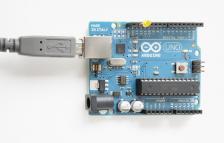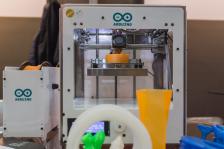How to Get Started with Arduino and Robotics Projects
Yikes! Arduino and robotics sounds complicated, right? It’s actually simpler than you might think. This week, Tech Talker will break it down step by step so you can get started with Arduino and robotics projects of your own.
Listen
How to Get Started with Arduino and Robotics Projects

For many of you, robotics may sound like a daunting hobby and even just starting a small project around the house can seem intimidating. I can assure you the barrier to entry is extremely low and the power it provides is pretty substantial to any project you want to apply it to.
What Is Arduino?
Arduino was created in 2005 as a means for individuals to have easy access to entry-level microcontroller programming. There are many different types of Arduinos, but the most popular is the Arduino Uno. It’s about the size of a credit card and comes with a USB port to attach to your computer, as well as a handful of pins you can plug in to motors and sensors.
.
The USB port allows you to easily plug your Arduino into your computer to program it, no matter what operating system you’re running. The pins then allow you to receive information from your environment. For example, I have a small temperature sensor attached to one of my Arduinos that tells me the temperature in my room every couple of minutes. The pins also let you control motors, relays, actuators, and a ton of other things, too.
One of the best places to get started is Arduino.cc, the main Arduino website. It’s packed with starter guides, forums for questions, and a ton of other great resources. The next best place for information is Adafruit.com. This website sells a ton of accessories, sensors, motors, and pretty much everything you would ever need for a project.
Buying accessories on Adafruit is a little bit more expensive than purchasing something from, say, eBay, but Adafruit has really high-quality guides and products. They take a lot of the guesswork and difficulty out of many projects, and it’s also a great place to get ideas for projects.
Arduino Starter Projects
Now, let’s get to the fun part. What can we actually do with an Arduino. Why would someone other than your resident techie (like yours truly) want an Arduino? Well, to answer this, let’s just take a look at some projects you can build.
At-Home Automated Watering System
Say you like gardening and never want to over- or under-water your plants, but you can’t always be there to monitor hydration levels. With an Arduino, you can set up a moisture sensor in the soil (available on Adafruit), and attach it to a flow controller, which is basically like your automated sprinkler system at home for your yard.
With this setup, whenever the soil reaches low moisture content, you can program the flow controller to turn on the water until it gets right back to the perfect moisture content. This way, you save money on water and your garden stays happy and healthy no matter what.
Beer Brewing Monitor

Automatic Chicken Feeder
Right now my chickens are fed automatically from an Arduino with a motor attached to their feeder and they’re also automatically let out of their coop in morning, and locked up at night all powered by an Arduino.
Alarm System
You can create an alarm system that will text you if a door is open after a certain time of night, or even if motion has been detected.
Types of Arduinos
If you haven’t realized it by now, you can do just about anything with an Arduino. In fact, they come in many shapes and sizes that allow you pick the perfect one for your needs. If you need to control a lot of sensors and motors, there’s the Arduino Mega, which gives you more pins for control. If you need something really small, there’s the Arduino Nano which is a little bit smaller than a thumb drive.
There’s even been a recent boom in ‘wearable’ Arduinos such as the Arduino Gemma, which can literally be sewn into clothes. You’re probably asking yourself, why you would want this sewn into your clothes? Well, you can use it for costumes, to control LEDs and screens, to make sounds, or even sense your pulse or blood pressure!

The only problem with Arduino is that once you get started it’s pretty hard to stop automating everything you can think of! Especially when it is so inexpensive.
The main Arduino Uno, which is the general starting point for most beginners, is around $24. However, I suggest getting the starter kit, which contains an array of boards, sensors, wires, LEDs, and a bunch of other great stuff for around $65.
Once you’ve become pretty familiar with Arduino, all of their designs are open source so you can buy the parts and make your own for around $4 each.
Whether you’re a student, teacher, parent, hobbyist, geek, or complete non-techie, the Arduino platform is a great and fun way to learn and do more with electronics that can affect, monitor, and change the world around you.
Now if you’ve done your own Arduino project, I’d love to hear about it! So please post it on the Tech Talker Facebook page. If I get enough I’ll feature them in a future podcast or blog post!
If you’d like me to go more in-depth with projects, sensors, or how-tos, feel free to email me at techtalker@quickanddirtytips.com.create new email
Well, that’s it for today! Be sure to check out all my earlier episodes at techtalker.quickanddirtytips.com. And if you have further questions about this podcast or want to make a suggestion for a future episode, post them on Facebook QDTtechtalker.
Until next time, I’m the Tech Talker, keeping technology simple!
Arduino image courtesy of goodcat / Shutterstock.com, Arduino 3d printer courtesy of Stefano Tinti / Shutterstock.com, Beer image from Shutterstock.com

